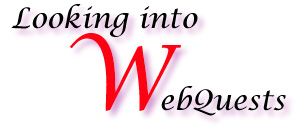
Introduction
Before you proceed, you need to know that this course is designed to utilize the WebQuest concept as a strategy for introducing inquiry into the k-12 curriculum. This site will guide you through your WebQuest project. Your first task is to look through a WebQuest designed for adult learners: What would Dewey Do?
As graduate students, you have learned to integrate a number of tools and strategies into the k-12 curriculum. You have also become aware of the crucial role that staff development plays in the process of curricular change and innovation. This course will extend the integration process by introducing and utilizing problem-solving strategies in a WebQuest format. You will have about two months to complete this long-term WebQuest. It must be uploaded no later than the second week in August. Note that long-term WebQuests for k-12 students take between one to four weeks to complete.
In reality, you are much more than graduate students. You have become producers of knowledge in a highly demanding learning environment. You are often asked about technology and how to integrate it with content-area standards, and you have responded by presenting many projects that stand up well in staff development and conference contexts. The WebQuest project will provide further resources for your students and faculties as you continue to refine and reform pedagogy for the 21st century.
Task
You are a member of an educational think tank consisting of 2 to 5 members. Your task is to enhance an aspect of the k-12 learning environment by developing an inquiry-based learning activity. In this activity, your students must be presented with a problem to investigate that will require locating information on the Internet, using that information and presenting their findings in a multimedia or web-based format. The WebQuest you create should take your students one to four weeks to complete.
Below are some examples of tasks k-12 teachers have created.
The interaction among individuals in the groups you create may lead to responses beyond those produced by one person in a single project. The understanding and interpretation of contexts as well as data is considered extremely important in a successful WebQuest.
In building your WebQuest, examine approaches that enhance your students' learning experiences by supporting their use of tools and Internet resources. Provide collaborative activities that help produce compelling learning environments by expanding the boundaries of the classroom into the community.
Information Resources
Scaffolding
In the link above, you should visit the links to visual and text-based scaffolds.
Process
1) As experienced educators, you have developed meaningful activities for your students thousands of times. The process for this task should be similar to the procedure you would use when creating any curricular experience. Begin by selecting your colleague(s). Then, use either the table scaffold or the diagram scaffold to brainstorm and record areas of common curricular interest for this project.
- Brainstorming scaffolds (pdf)
- table scaffold (9Kb)
- diagram scaffold (46Kb)
Note: Your students may experience a similar collaborative process. There are many scaffolding ideas for your students provided in WebQuest examples. Below is a scaffold example for adult learners. See the examples in the links above for further clarification.
- scaffold example for adult learners
2) Examine the areas of common interest you and your colleagues have determined.
- Common interest scaffolds (pdf)
- Area of Focus (7Kb)
- roles (8Kb)
3) Locate Internet resources that will provide you with the URLs necessary to enhance the learning of your students.
4) Build the website collaboratively.
5) Build the scaffolds for meaningful learning.
6) Present your product.
Evaluation and Support
Conclusions
Thanks to Bernie Dodge for creating the WebQuest strategy with all its support materials.
Thanks also to Rob Freeman for creating the excellent Powerpoint Tutorial.
WebQuests: Ancient Civilizations
![]() Click the beanie to return to Problem Solving and Project Development.
Click the beanie to return to Problem Solving and Project Development.